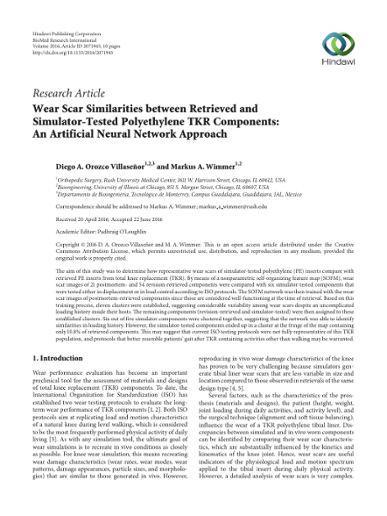| dc.creator | Diego A. Orozco Villase�or | |
| dc.creator | Markus A. Wimmer | |
| dc.date | 2016 | |
| dc.date.accessioned | 2018-10-18T15:34:04Z | |
| dc.date.available | 2018-10-18T15:34:04Z | |
| dc.identifier.issn | 23146133 | |
| dc.identifier.doi | 10.1155/2016/2071945 | |
| dc.identifier.uri | http://hdl.handle.net/11285/630256 | |
| dc.description | The aim of this study was to determine how representative wear scars of simulator-tested polyethylene (PE) inserts compare with retrieved PE inserts from total knee replacement (TKR). By means of a nonparametric self-organizing feature map (SOFM), wear scar images of 21 postmortem- and 54 revision-retrieved components were compared with six simulator-tested components that were tested either in displacement or in load control according to ISO protocols. The SOFM network was then trained with the wear scar images of postmortem-retrieved components since those are considered well-functioning at the time of retrieval. Based on this training process, eleven clusters were established, suggesting considerable variability among wear scars despite an uncomplicated loading history inside their hosts. The remaining components (revision-retrieved and simulator-tested) were then assigned to these established clusters. Six out of five simulator components were clustered together, suggesting that the network was able to identify similarities in loading history. However, the simulator-tested components ended up in a cluster at the fringe of the map containing only 10.8% of retrieved components. This may suggest that current ISO testing protocols were not fully representative of this TKR population, and protocols that better resemble patients' gait after TKR containing activities other than walking may be warranted. © 2016 Diego A. Orozco Villaseñor and Markus A. Wimmer. | |
| dc.language | eng | |
| dc.publisher | Hindawi Limited | |
| dc.relation | https://www.scopus.com/inward/record.uri?eid=2-s2.0-84984691282&doi=10.1155%2f2016%2f2071945&partnerID=40&md5=ba44a7dc931e384ae47fb9995060c900 | |
| dc.relation | Investigadores | |
| dc.relation | Estudiantes | |
| dc.rights | info:eu-repo/semantics/openAccess | |
| dc.rights.uri | http://creativecommons.org/licenses/by-nc-nd/4.0 | |
| dc.source | BioMed Research International | |
| dc.subject | polyethylene | |
| dc.subject | polyethylene | |
| dc.subject | Article | |
| dc.subject | artificial neural network | |
| dc.subject | controlled study | |
| dc.subject | data mining | |
| dc.subject | female | |
| dc.subject | human | |
| dc.subject | interrater reliability | |
| dc.subject | male | |
| dc.subject | scar | |
| dc.subject | simulator | |
| dc.subject | total knee arthroplasty | |
| dc.subject | artificial neural network | |
| dc.subject | computer simulation | |
| dc.subject | gait | |
| dc.subject | knee replacement | |
| dc.subject | pathophysiology | |
| dc.subject | physiology | |
| dc.subject | prostheses and orthoses | |
| dc.subject | rehabilitation | |
| dc.subject | scar | |
| dc.subject | Arthroplasty, Replacement, Knee | |
| dc.subject | Cicatrix | |
| dc.subject | Computer Simulation | |
| dc.subject | Gait | |
| dc.subject | Humans | |
| dc.subject | Neural Networks (Computer) | |
| dc.subject | Polyethylene | |
| dc.subject | Prostheses and Implants | |
| dc.subject.classification | 7 INGENIERÍA Y TECNOLOGÍA | |
| dc.title | Wear Scar Similarities between Retrieved and Simulator-Tested Polyethylene TKR Components: An Artificial Neural Network Approach | |
| dc.type | Artículo | |
| dc.identifier.volume | 2016 | |
| refterms.dateFOA | 2018-10-18T15:34:04Z | |

